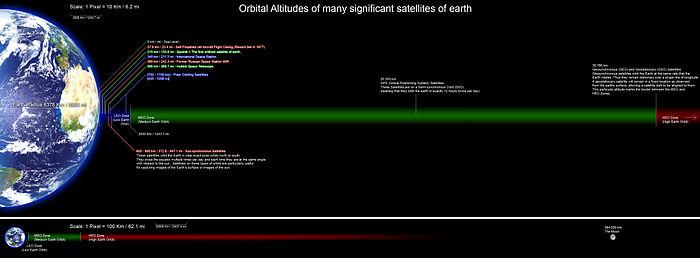Low Earth Orbit
A low Earth orbit (LEO) is an orbit around Earth with an altitude between the Earth's surface and 2,000 kilometers (1,200 mi), with an orbital period of between about 84 and 127 minutes. Objects below approximately 160 kilometers (99 mi) will experience very rapid orbital decay and altitude loss.
With the exception of the 24 astronauts who flew lunar flights in the Apollo program during the four-year period spanning 1968 through 1972, all human spaceflights have taken place in LEO or below. The International Space Station conducts operations in LEO. The altitude record for a human spaceflight in LEO was Gemini 11 with an apogee of 1,374.1 kilometers (853.8 mi). All crewed space stations to date, as well as the majority of satellites, have been in LEO.
Orbital characteristics
Objects in LEO encounter atmospheric drag from gases in the thermosphere (approximately 80–500 km up) or exosphere (approximately 500 km and up), depending on orbit height. Due to atmospheric drag, satellites do not usually orbit below 300 km. Objects in LEO, orbit Earth between the denser part of the atmosphere and below the inner Van Allen radiation belt.
GOCE orbited at about 255 km and had an aerodynamic shape and ion thrusters to reduce and compensate for atmospheric drag.
The mean orbital velocity needed to maintain a stable low Earth orbit is about 7.8 km/s, but reduces with increased orbital altitude. Calculated for circular orbit of 200 km it is 7.79 km/s and for 1500 km it is 7.12 km/s. The delta-v needed to achieve low Earth orbit starts around 9.4 km/s. Atmospheric and gravity drag associated with launch typically adds 1.3–1.8 km/s to the launch vehicle delta-v required to reach normal LEO orbital velocity of around 7.8 km/s (28,080 km/h).

Equatorial low Earth orbits (ELEO) are a subset of LEO. These orbits, with low inclination to the Equator, allow rapid revisit times and have the lowest delta-v requirement (i.e., fuel spend) of any orbit. Orbits with a high inclination angle to the equator are usually called polar orbits.
Higher orbits include medium Earth orbit (MEO), sometimes called intermediate circular orbit (ICO), and further above, geostationary orbit (GEO). Orbits higher than low orbit can lead to early failure of electronic components due to intense radiation and charge accumulation.
Use of LEO

Roughly half an orbit of the ISS.
Although the Earth's pull due to gravity in LEO is not much less than on the surface of the Earth, people and objects in orbit experience weightlessness because they are in free fall.
A low Earth orbit is simplest and cheapest for satellite placement. It provides high bandwidth and low communication time lag (latency), but satellites in LEO will not be visible from any given point on the Earth at all times.
Examples
· Earth observation satellites and spy satellites use LEO as they are able to see the surface of the Earth more clearly as they are not so far away. They are also able to traverse the surface of the Earth. A majority of artificial satellites are placed in LEO, making one complete revolution around the Earth in about 90 minutes.
· The International Space Station is in a LEO about 400 km (250 mi) above the Earth's surface. and needs reboosting a few times a year due to orbital decay.
· Since it requires less energy to place a satellite into a LEO and the LEO satellite needs less powerful amplifiers for successful transmission, LEO is used for many communication applications. Because these LEO orbits are not geostationary, a network (or "constellation") of satellites is required to provide continuous coverage. (Many communication satellites require geostationary orbits, and move at the same angular velocity as the Earth. Some communications satellites including the Iridium phone system use LEO.)
· Lower orbits also aid remote sensing satellites because of the added detail that can be gained. Remote sensing satellites can also take advantage of sun-synchronous LEO orbits at an altitude of about 800 km (500 mi) and near polar inclination. Envisat is one example of an Earth observation satellite that makes use of this particular type of LEO.
· GOCE orbited at about 255 km to measure the earth's gravity field.
· Hubble Space Telescope orbits at about 540 km.
Space debris
The LEO environment is becoming congested with space debris due to the frequency of object launches. This has caused growing concern in recent years, since collisions at orbital velocities can easily be dangerous, and even deadly. Collisions can produce even more space debris in the process, creating a domino effect, something known as Kessler Syndrome. The Joint Space Operations Center, part of United States Strategic Command (formerly the United States Space Command), currently tracks more than 8,500 objects larger than 10 cm in LEO.However, a limited Arecibo Observatory study suggested there could be approximately one million objects larger than 2 millimeters, which are too small to be visible from Earth-based observatories.

